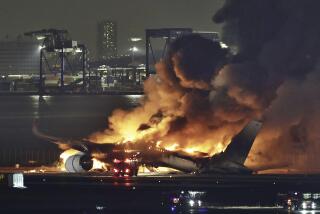Lockerbie Investigators Call for Bombproof Aircraft
- Share via
LONDON — A British government report into the 1988 bombing of a Pan Am jumbo jet that killed 270 people called today for aircraft builders to find ways to make bombproof planes.
The Transport Department report covered technical aspects of the bombing of Pan Am Flight 103 over Lockerbie, Scotland, on Dec. 21, 1988. It did not look into security questions or try to find who was responsible.
An improvised bomb in the Boeing 747’s left-forward cargo hold exploded at 31,000 feet, the report said, and the plane broke apart within seconds, killing all 259 people on board. Eleven people were killed on the ground.
The report described in technical terms how the jet was blown apart, leaving an 80-mile trail of wreckage.
“The direct explosive forces produced a large hole in the fuselage structure and disrupted the main cabin floor,” the report noted. “Major cracks continued to propagate from the large hole under the influence of the service pressure differential.”
It said the forward fuselage and flight deck area separated from the rest of the plane within seconds. Most of the remaining aircraft disintegrated as it plunged to the ground.
Autopsies showed that passengers had multiple injuries consistent with in-flight disintegration and ground impact.
There were no last words from the cockpit, just “a sudden loud sound” on the voice recorder. The flight data recorder stopped suddenly without registering any explosion.
“The accident was not survivable,” the report said.
Britain’s Civil Aviation Authority said it would be impossible to build an aircraft able to survive an explosion as strong as the one that destroyed Flight 103.
“But we can perhaps design aircraft to withstand smaller explosions. . . . It’s a formidable task, but we don’t close our minds to this recommendation.”
More to Read
Sign up for Essential California
The most important California stories and recommendations in your inbox every morning.
You may occasionally receive promotional content from the Los Angeles Times.










